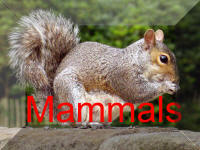Brown Hare ( Lepus europaeus ) DescriptionVery long black-tipped ears; large powerful hind legsHead/body length: 520-595mm; tail: 85-120mm
Weight: average 3-4kgEcology:Brown hares were probably introduced, since there is no evidence of their presence in Britain before Roman times. They are widespread on low ground throughout England. Although they have been introduced to Northern Ireland, they have not spread far. In Scotland brown hares are found on farmland and rough grazing to the far north of the mainland, but are absent from parts of the North West. Brown hares are replaced by mountain hares in upland areas of Scotland and central England.
Brown hares live in very exposed habitats, and they rely on acute senses they can achieve running speeds of up to 70kph (45mph) to evade predators. Hares are not burrow dwellers , but make a small depression in the ground among long grass - this is known as a form. They spend most of the day on or near the form, moving out to feed in the open at night. Tender grass shoots, including cereal crops, are their main foods. Though generally solitary, hares sometimes band into loose groups when feeding.
Breeding takes place between February and September and a female can rear three or four litters a year, each of two to four young. Young Hares are , known as leverets, are born fully furred with their eyes open and are left by the female in forms a few metres from their birth place. Once a day for the first four weeks of their lives, the leverets gather at sunset to be fed by the female, but otherwise they receive no parental care. This avoids attracting predators to the young at a stage when they are most vulnerable. Foxes are important predators of young hares and where foxes are common there are likely to be few hares. Adult hares normally live to 3 or 4 years but very rarely can they live much longer. Many hares die of disease each year.
Conservation:Brown hares have little legal protection, partly because they are game animals and can be managed by farmers and landowners, and partly because they are also a minor pest and can damage crops and young tree plantations.
Numbers of hares have declined substantially since the beginning of this century, though they are still common animals in many parts of the country. The main reason for this decline seems to be farming practice Today's modern farms are intensive and specialised, either growing crops like wheat and oilseed rape, or raising livestock for meat and dairy produce. A hundred years ago most farms were mixed enterprises. Mixed farms have a patchwork quilt of fields which provide year-round grazing for hares as well as long crops for them to hide in. Modern cereal farms provide little or no food for hares in late summer and autumn, and livestock farms have few crops for them the hide in. Modern farm machinery and pesticides also kill many hares.
Another reason is that there now appear to be many more foxes in the countryside than there were a hundred years ago - this is probably because there are now fewer gamekeepers and fewer farmers who kept fox numbers down in the past.
Hare shooting still occurs in areas where hares are common and where farms want to reduce crop damage. Hare hunting with beagles and harriers occurs throughout Britain, and hare coursing events are run be several coursing clubs. Hares are very often poached, particularly with lurchers cross-bred from collies and greyhounds.
Questions:What is "March madness"?
This is part of hare breeding behaviour. The rapid chases are a dominant male driving a rival away from a female he is guarding. "Boxing" is usually a rebuff given by a female to an over-amorous male.Do hares get myxomatosis?
No, the disease is confined to rabbits.How can you tell hares from rabbits?
Differences include the large staring yellow eyes, reddish-brown grizzled fur and black tips to the ears of hares.How many species of hare are there in Britain?
Two; the mountain, or blue hare Lepus timidus replaces the brown hare on high ground in the North of England and Wales, in the North of Scotland and in Ireland.

